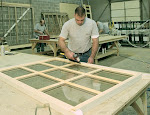
-
Scheduling the different trades is always a challenge and when you combine an abatement, restoration, glazing, and painting subcontractor with a window manufacturer, there is plenty of potential for serious delays. Many of these companies are very small specialty shops that can easily get bogged down with other work that will inhibit their ability to perform on your project. It is very important to line out the schedules of all of the trades and get a commitment from all of the players. It is also important to select players who have the capacity to meet the respective deadlines. Check backlogs of work and visit the facilities of each sub to verify availability. -
It is critical that the various trades understand their scope of work and how it affects the trades that follow. The last thing you need is to have an abatement contractor tear up a wood window in an attempt to remove lead-based paint. We have seen many projects where one trade contributes cost and delays to the subs who follow because they either don't care or don't understand the big picture. -
Quality control at each step becomes a major burden in managing multiple trades. You will have big problems if you rely on each subcontractor to monitor their own work and fail to regularly check on their progress. We have seen problems with failures to neutralize strippers, excessive use of epoxies, insufficient paint mil thickness, faulty glazing, or sloppy carpentry. It is amazing how even a small quality control problem can derail an entire project. -
The instability of our current economic environment also places a risk factor in managing multiple subcontractors to perform a window restoration project. As a consequence, we have seen a dramatic increase in bonding requirements for basic preservation projects. Many of the small specialty subcontractors in this business can't bond their work, increasing the risk for the general contractor. -
Often window restoration projects are awarded as bid packages where the lead contractor strings together his subs and bids the package to the construction manager. This type of project management can become expensive since the lead contractor is marking up all of the subs who have individual G&A and profit markups in their price as well. There really isn't room for multiple markups in this economy. -
I must give my economics professors of the past a little recognition and mention the opportunity costs for a general contractor to manage multiple subcontractors on a window restoration project. All of the time spent on scheduling, quality control, and scope conflict could be spent on other work associated with the project. Windows shouldn't occupy a large percentage of the building team's time.
For many of the reasons outlined above, we are seeing an increase in specifications that demand a single company to manage all historic window activities. These projects are referred to as single source responsibility or turnkey scopes of work. The people at Re-View refer to this as our "One Butt to Kick" philosophy.
Eleven years ago, Re-View recognized the benefit of becoming a turnkey operation. We grew weary of having to deal with the problems and challenges of our many subcontractors. When you enter into a business contract with another company, you are getting into bed with this organization for the duration of the project. You are buying into the ownership and employees of all your subs. We found that problems and delays caused by subcontractors, manufacturers, and suppliers became our greatest challenge to successfully completing a project. To compound our ordeal, there seem to be very few companies that have experience in this field. It isn't like you can quickly change horses when one of your subs is swamped with other work or goes out of business. That is a big reason why the bonding companies seem to have a distaste for this industry.Re-View has successfully developed competencies in abatement, field and shop restoration of wood and steel windows, manufacturing of historically correct wood windows, window finishing, and union field installation. Since we control the resources associated with these disciplines we can more effectively manage scheduling and produce better and more consistent quality. The ability to provide a turnkey package also enables our company to become better at everything we do. For instance, our ability to manufacture historic window replicas is improved when we understand the complexities of window installation.






